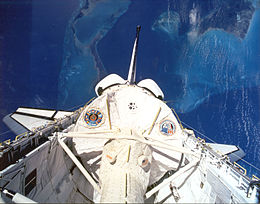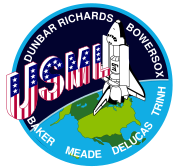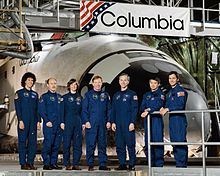
Back STS-50 Arabic STS-50 Bulgarian STS-50 Czech STS-50 Danish STS-50 German استیاس-۵۰ Persian STS-50 French STS-50 Galician STS-50 HE STS–50 Hungarian
This article needs additional citations for verification. (April 2024) |
 Spacelab Module LM1 in Columbia's payload bay, serving as the United States Microgravity Laboratory. | |
| Names | Space Transportation System-50 |
|---|---|
| Mission type | USML-1 microgravity research |
| Operator | NASA |
| COSPAR ID | 1992-034A |
| SATCAT no. | 22000 |
| Mission duration | 13 days, 19 hours, 30 minutes, 4 seconds |
| Distance travelled | 9,200,000 km (5,700,000 mi) |
| Orbits completed | 221 |
| Spacecraft properties | |
| Spacecraft | Space Shuttle Columbia |
| Launch mass | 116,693 kg (257,264 lb) |
| Landing mass | 103,814 kg (228,871 lb) |
| Payload mass | 12,101 kg (26,678 lb) |
| Crew | |
| Crew size | 7 |
| Members | |
| Start of mission | |
| Launch date | June 25, 1992, 16:12:23 UTC (12:12:23 pm EDT) |
| Launch site | Kennedy, LC-39A |
| Contractor | Rockwell International |
| End of mission | |
| Landing date | July 9, 1992, 11:42:27 UTC (7:42:27 am EDT) |
| Landing site | Kennedy, SLF Runway 33 |
| Orbital parameters | |
| Reference system | Geocentric orbit |
| Regime | Low Earth orbit |
| Perigee altitude | 302 km (188 mi) |
| Apogee altitude | 309 km (192 mi) |
| Inclination | 28.46° |
| Period | 90.60 minutes |
| Instruments | |
| |
 STS-50 mission patch  From left: Baker, Bowersox, Dunbar, Richards, Meade, Trinh and DeLucas | |
STS-50 (U.S. Microgravity Laboratory-1) was a NASA Space Shuttle mission, the 12th mission of the Columbia orbiter. Columbia landed at Kennedy Space Center for the first time ever due to bad weather at Edwards Air Force Base caused by the remnants of Hurricane Darby.[1][2]
- ^ "STS-50". Archived from the original on February 16, 2010. Retrieved February 8, 2022.
 This article incorporates text from this source, which is in the public domain.
This article incorporates text from this source, which is in the public domain.
- ^ "Preliminary Report Hurricane Darby". NOAA. August 9, 1992. Retrieved February 8, 2022.
 This article incorporates text from this source, which is in the public domain.
This article incorporates text from this source, which is in the public domain.